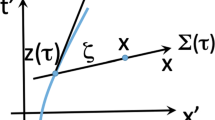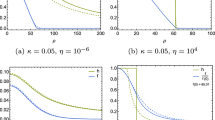Abstract
Intrinsically stable or “fundamental” solitons may be decorated with conserved charges which are pieces of those carried by elementary particles in the same medium. These “hairs” are always significant in principle, and in the strong-coupling regime (where solitons and particles exchange roles) they may become major factors in dynamics.
Access this chapter
Tax calculation will be finalised at checkout
Purchases are for personal use only
Preview
Unable to display preview. Download preview PDF.
Similar content being viewed by others
References
P. A. M. Dirac, Proc. R. Soc. London Sec. A 133 (1931), 60.
C. J. Goebel, In: Quanta (P. G. O. Freund, et al., eds.) Chicago, University Chicago, 1970, 338; A. S. Goldhaber, Magnetic Monopoles (R. A. Carrigan, Jr. and W. P. Trower, eds.) vol. 1, Plenum, New York, 1983.
A. S. Goldhaber, ITP 97-61, 1997.
A. S. Goldhaber, ITP 97-62, November 1997.
A. S. Goldhaber, In: Workshop on Foundations of Quantum Mechanics (T. D. Black, et al., eds.) World Scientific, Singapore, 1992.
A. S. Goldhaber and J. K. Jain, Phys. Lett. A 199 (1995), 267.
A. S. Goldhaber and S. A. Kivelson, Phys. Lett. B 255 (1991), 445.
J. Goldstone and F. Wilczek, Phys. Rev. Lett. 47 (1981), 986.
R. Jackiw and C. Rebbi, Phys. Rev. D 13 (1976), 3398.
R. Jackiw and J. R. Schrieffer, Nuclear Phys. B 190 (1981), 253.
S. Kivelson and J. R. Schrieffer, Phys. Rev. B 25 (1982), 6447; R. Rajaraman and J. S. Bell, Phys. Lett. B 116 (1982), 151; S. A. Kivelson, Phys. Rev. B 26 (1982), 4269; J. S. Bell and R. Rajaraman, Nuclear Phys. B 220 (1983), 1; Y. Frishman and B. Horovitz, Phys. Rev. B 27 (1983), 2565; R. Jackiw, A. K. Kerman, I. Klebanov, and G. Semenoff, Nuclear Phys. B 225 (1983), 233
M. P. Mattis, Chapter 19, in this book.
C. Montonen and D. Olive, Phys. Lett. B 72 (1977), 117; P. Goddard, J. Nuyts, and D. Olive, Nuclear Phys. B 125 (1977), 1; E. Witten and D. Olive, Phys. Lett. B 78 (1978), 97; H. Osborn, Phys. Lett. B 83 (1979), 321; A. Sen, Internat. J. Modern Phys. A 9 (1994), 3707; N. Seiberg and E. Witten, Nuclear Phys. B 426 (1994), 19; Erratum, Nuclear Phys. B 430 (1994), 485.
H. Poincaré, C. R. Acad. Sci. 123 (1996), 530.
M. Requardt, Comm. Math. Phys. 50 (1976), 259.
M. Rho, A. S. Goldhaber, and G. E. Brown, Phys. Rev. Lett. 51 (1983), 747; J. Goldstone and R. L. Jaffe, Phys. Rev. Lett. 51 (1983), 1518.
N. Seiberg and E. Witten, Nuclear Phys. B 431 (1994), 484.
R. Shankar and E. Witten, Nuclear Phys. B 141 (1978), 349; Nuclear Phys. B 148 (1979), 538 (E); E. Witten, Nuclear Phys. B 142 (1978), 285.
T. H. R. Skyrme, Proc. R. Soc. London Sec. A 260 (1961), 127.
W. P. Su, J. R. Schrieffer, and A. J. Heeger, Phys. Rev. Lett. 42 (1979), 1698.
F. Wilczek, Phys. Rev. Lett. 48 (1982), 1146; A. S. Goldhaber, R. MacKenzie, and F. Wilczek, Modern Phys. Lett. A 4 (1989), 21.
E. Witten, Nuclear Phys. B 223 (1983), 433; E. D’Hoker and E. Farhi, Phys. Lett. B 134 (1984), 86.
T. T. Wu and C. N. Yang, Phys. Rev. D 12 (1975), 3845.
S. C. Zhang, S. Kivelson, and A. S. Goldhaber, Phys. Rev. Lett. 58 (1987), 213.
Editor information
Editors and Affiliations
Rights and permissions
Copyright information
© 2000 Springer Science+Business Media New York
About this paper
Cite this paper
Goldhaber, A.S. (2000). Hairs on the Unicorn: Fine Structure of Monopoles and Other Solitons. In: MacKenzie, R., Paranjape, M.B., Zakrzewski, W.J. (eds) Solitons. CRM Series in Mathematical Physics. Springer, New York, NY. https://doi.org/10.1007/978-1-4612-1254-6_7
Download citation
DOI: https://doi.org/10.1007/978-1-4612-1254-6_7
Publisher Name: Springer, New York, NY
Print ISBN: 978-1-4612-7063-8
Online ISBN: 978-1-4612-1254-6
eBook Packages: Springer Book Archive




